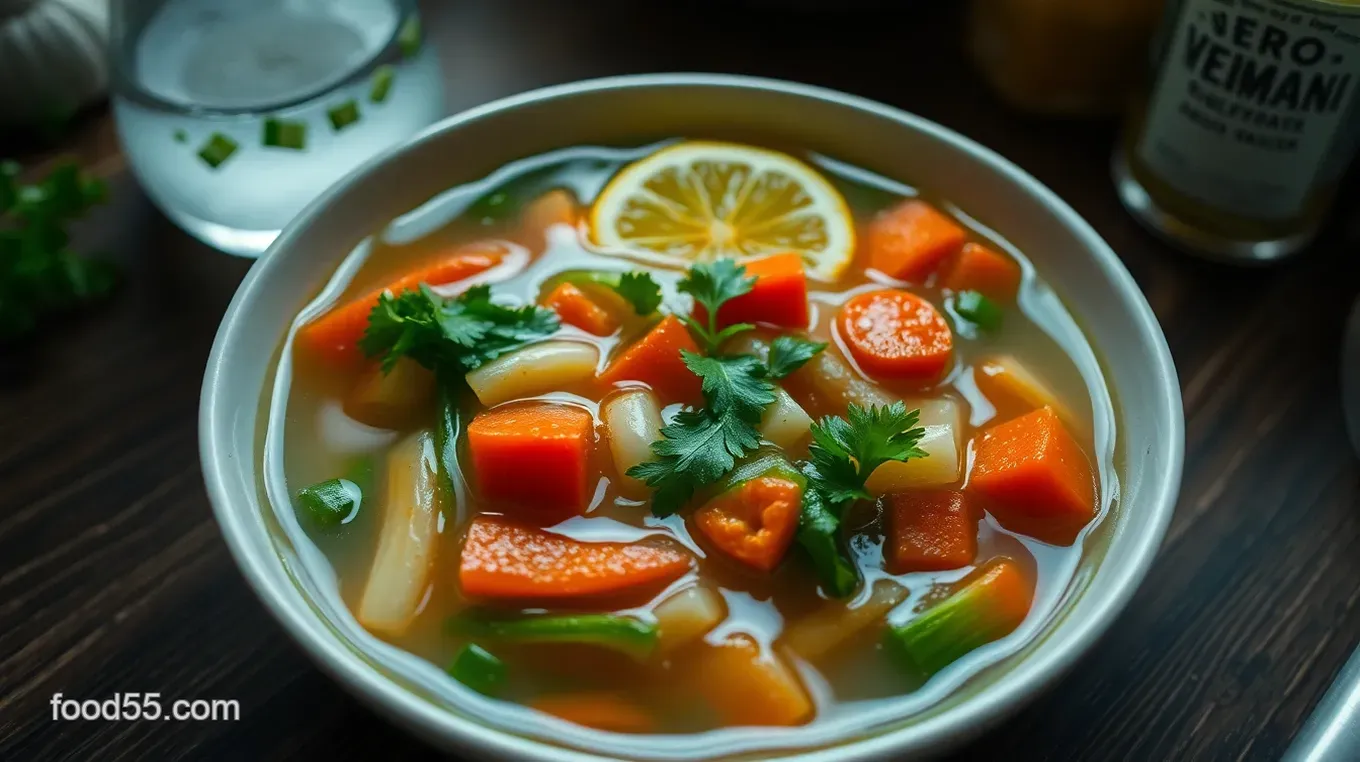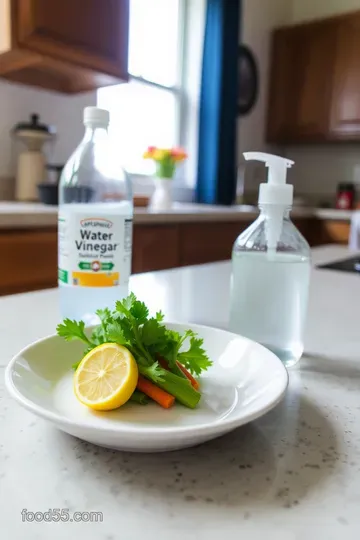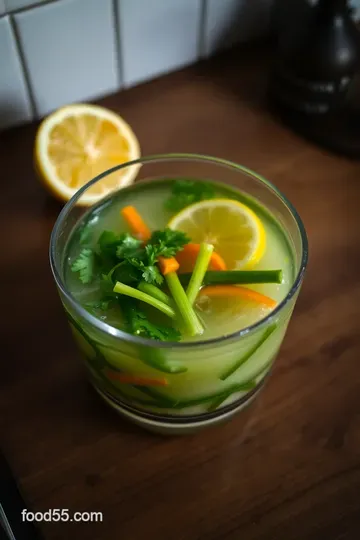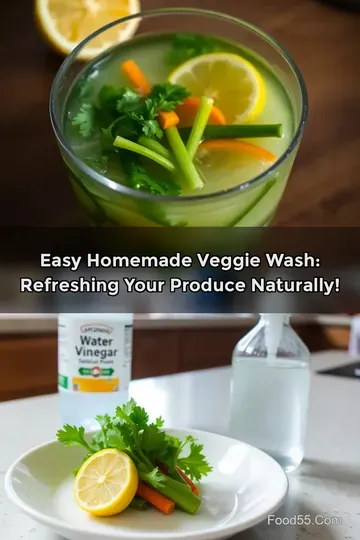Revitalizing Homemade Veggie Wash: Keep Your Produce Fresh!
Refresh your produce with this easy homemade veggie wash! Free from dirt and pesticides, it's the key to healthier meals. Discover my tips inside!

- Fresh Start: The Power of Homemade Veggie Wash
- The Lowdown on Veggie Wash
- Why You Need This in Your Life
- The Sweet Essence of Homegrown Cleanliness
- Your Essential Ingredients Guide for Home Cooking
- Mastering the Art of Professional Cooking: The Essential Guide
- A Fresh Take: All About Your Homemade Veggie Wash
- Frequently Asked Questions
- Recipe Card
Fresh Start: The Power of Homemade Veggie Wash
Oh my gosh, do you ever stop to think about what you’re actually eating? i remember this one time at the farmer's market when i picked up a basket of vibrant strawberries.
They looked so perfect, but i couldn’t shake the feeling of how many hands had touched them. that’s when i began to wonder - how clean are our fruits and veggies really? this little thought spun me down a rabbit hole, and eventually, i discovered the magic of homemade veggie wash .
Have you ever thought about making your own? it’s honestly simpler than you might think. the stars of this recipe are basic kitchen staples - distilled vinegar and lemon juice.
Does it sound weird? maybe. but trust me, your produce will thank you.
The Lowdown on Veggie Wash
Now, let’s get into the nitty-gritty of this delightful concoction, shall we? the practice of washing produce is actually a bit of a tradition.
People have been doing it for ages, long before fancy fruit and veggie wash bottles hit supermarket shelves. originally, folks would just pour water over their veggies, assuming that’s all it took.
But with today's farming practices, those sweet veggies can be coated in dirt, pesticides, and, let’s be real, who knows what else.
In the modern world, this homemade magic has gained popularity. everyone from health ensoiasts to busy moms is looking for ways to keep their food clean while keeping it affordable.
It takes just five minutes to whip up a batch! plus, you probably already have the ingredients at home. win-win!
Why You Need This in Your Life
Alright, let's chat about the benefits. first off, using a veggie wash like this really boosts your food’s healthiness. we all strive to eat fresh, but it's hard to enjoy a salad when you’re worried about what’s lurking on the leaves.
Vinegar is a natural disinfectant that cuts through gunk and pairs perfectly with the zesty kick of lemon juice.
This homemade wonder not only cleans but also extends the shelf life of your fruits and veggies. ever opened your fridge to a sad, wilted bunch of greens? yeah, nobody wants that.
Using a fruit and vegetable wash helps keep everything crisp and fresh. plus, it’s an easy way to impress guests.
“oh, you washed these with homemade veggie wash? how fancy!”
It’s perfect for gatherings, Sunday meal preps, and, let’s be real, those lazy weekday dinners where you’re throwing a salad together. Plus, it’s way better than store-bought washes that can get pricey.
The Sweet Essence of Homegrown Cleanliness
Now, if you’re a bit skeptical about vinegar smells, i get it. but here’s the beautiful part – after rinsing off, you won’t even taste it.
What you will taste is the crisp freshness of your produce. and if you are feeling adventurous, you can always customize your wash.
I sometimes add a sprig of mint for a refreshing twist.
So, why not take five minutes to elevate your kitchen game? get ready to transform your fruits and veggies into fresh delights.
The next section will dive into the ingredients you’ll need for this easy, effective homemade veggie wash recipe that’ll leave your produce gleaming like it just won a beauty pageant!

Your Essential Ingredients Guide for Home Cooking
Let’s talk about the building blocks of any great kitchen: the essential ingredients! whether you’re a cooking newbie or a culinary whiz, knowing your basics can seriously up your game.
You ever hear the saying, “you can’t make an omelet without breaking eggs”? well, that’s because premium core components make all the difference!
Premium Core Components: What You Need
First off, let’s break down your premium core components . This is where flavor magic starts!
Detailed Measurements
When you’re tossing together a recipe, having the right measurements is crucial. for example, when using vinegar in your homemade veggie wash , you’ll want exactly 1 cup (240 ml) of distilled white vinegar.
Not only do precise measurements help in baking, but they also make your dishes sing!
Quality Indicators for Ingredients
Next up, how do you know you’re getting the good stuff? look for quality indicators! buy fresh produce that’s firm, colorful, and not bruised.
And when it comes to spices, freshness matters! outdated herbs can taste like cardboard – no thanks!
Storage Guidelines and Shelf Life
Many ingredients, like spices and oils, have a shelf life. always check the date. if your spice rack looks like it’s been through a time warp, it’s time to clear it out.
Store your ingredients properly (cool, dry places for spices, and airtight containers for everything else) to keep them fresh longer.
Freshness Tips
Think of your ingredients like a secret superhero. keep an eye out for freshness! when buying fruits and veggies, check for firmness and vibrant colors.
If you’re uncertain, hydration is key – give them a wash! and speaking of washing, this is where a good fruit and veggie wash comes in handy.
Signature Seasoning Blend: Let's Spice It Up
Now, onto my favorite part: signature seasoning blends . Honestly, if you don’t have a few go-to spice combos, are you even living?
Essential Spice Combinations
Start with the classics: garlic powder, onion powder, and paprika. Toss those in your chili or on some roasted veggies, and you’ll be in flavor heaven!
Herb Selections and Pairings
Don’t forget about herbs! Basil pairs beautifully with tomatoes, while dill is perfect for cucumbers. Get creative! Mix 'em up for unique flavor explosions!
Flavor Enhancers
Want to kick things up a notch? Look for flavor enhancers like sriracha , soy sauce, or even a splash of citrus. These can turn a bland dish into a masterpiece!
Smart Substitutions: When You’re Out of Ingredients
We’ve all been there—standing in front of the fridge, realizing you're missing a key ingredient. No panic, my friend!
Common Alternatives
Run out of buttermilk? Use a mix of milk and vinegar. Need some fresh herbs but have dried? Just use a pinch!
Dietary Modifications
For those with dietary restrictions, don't fret! You can easily swap dairy for nut milk or honey for agave syrup without losing too much of the original flavor.
Emergency Replacements
Face it, sometimes you just need an emergency replacement . A little creativity can lead to amazing discoveries in the kitchen. Don't be afraid to experiment!
Kitchen Equipment Essentials: Tools You Can’t Live Without
Now, let’s get into the nitty-gritty: kitchen equipment essentials . Because what good are your ingredients if you don’t have the right tools?
Must-Have Tools
Get yourself a good chef’s knife, a sturdy cutting board, and a reliable set of measuring spoons. Trust me, these are your kitchen trifecta !
Alternative Equipment Options
Don’t stress if you don’t have fancy gadgets. A good ol’ pot can substitute for a chef’s pan, and many blenders can double as food processors. Work with what you got!
Preparation Tips
Think of prep as your secret weapon. Read your recipes fully before diving in, and you’ll avoid the “oh my gosh, I forgot to chop the onions!” moment.
Final Thoughts
Getting the hang of these essential ingredients, seasonings, and tools will set you on a delicious path. remember, cooking is about experimenting and having fun! now that you have the basics down, let’s dive into some healthy and tasty recipes.
Next up, we’re talking about that revitalizing homemade veggie wash to keep your produce fresh and ready to shine! stay tuned, and let’s keep that kitchen rocking!

Mastering the Art of Professional Cooking: The Essential Guide
Cooking like a pro? you bet! whether you're dreaming of michelin stars or just want to impress your friends at the next dinner party, mastering professional cooking methods is key.
And trust me, it starts with some essential preparation steps .
Essential Preparation Steps
First up, let’s chat about mise en place . this fancy french term basically means "everything in its place." before you even think about turning on the stove, gather all your ingredients.
Chop, measure, and prep like you’re on a cooking show! i remember my first big dinner party—i forgot the garlic until the last minute.
Rookie mistake!
Now, onto time management . set a timer for everything! use your phone or that cute little timer you got stuck in a drawer.
Timing can make or break a dish. for example, when cooking meat, keep an eye out for that internal temperature of 165° f —you don't want food poisoning, trust me!
Speaking of staying organized, keep your workspace clean. a cluttered kitchen can lead to a cluttered mind. plus, if you're juggling tasks, it's easier to mess something up.
Finally, don't overlook safety considerations —always have your first aid kit handy, and remember that knife skills take practice!
Step-by-Step Process
Okay, now let’s dive into the step-by-step process of professional cooking. Here’s a quick breakdown:
-
Prep Your Ingredients : Egg on your face 'cause you forgot something? No way!
-
Temperature Control : Keep that oil hot, but not smoking—aim for about 350° F for frying.
-
Timing Precision : Timing is everything, especially with things like pasta. Aim for al dente, which usually means about 8- 10 minutes boiling, depending on the type.
-
Visual Cues for Doneness : Trust your eyes. Chicken should be golden brown, veggies should have that lovely bright color, and pasta should have a little bite to it.
Expert Techniques
Ready for some expert techniques ? let’s talk about searing. it’s not just a fancy word—getting that perfect crust on your meat adds flavor.
First, make sure your pan is smoking hot! and remember, do not overcrowd the pan; that’ll steam it instead.
Critical steps here involve resting. let your meat chill out for a few minutes after cooking. this ensures all those tasty juices don’t run out.
For quality checkpoints, check for color and texture. if something looks off, trust your kitchen instincts!
Got a problem? Don’t panic! For burning, add a splash of stock to lift the flavors.
Success Strategies
Everyone makes mistakes; it’s part of cooking! to avoid common blunders, always read the recipe fully before starting. just the other week, i forgot to add salt at the right time.
Total facepalm!
Quality assurance tips : use fresh ingredients, and if you’re making a homemade veggie wash , it’ll keep your produce fresher longer.
A simple recipe of 1 cup of vinegar and 1 cup of water gets the job done!
Want perfect results every time? Try out make-ahead options. For example, prep sauces or marinades in advance. You’ll thank yourself when you're rushing around last minute.
Wrapping It Up
There you have it! with these techniques and handy tips, cooking can go from daunting to downright enjoyable. armed with your new knowledge, you’ll impress everyone, from your family to your friends.
Don’t forget those vinegar uses for cleaning your produce with a fruit and veggie wash . keeping your ingredients clean is just as important as cooking them right.
In our next section, we’ll explore some additional information . There’s always more to learn in the world of cooking, and I can't wait to share it with you! Happy cooking, my friends!

A Fresh Take: All About Your Homemade Veggie Wash
So, you’ve decided to give your fruits and veggies the tlc they deserve! this homemade veggie wash is a game changer.
Not only does it make your produce look fresh, but it keeps nasty stuff like pesticides and dirt at bay.
I mean, we all want our salads to be as clean as a whistle, right? let’s dive into some pro tips, presentation hacks, storage tricks, and even fun variations to keep your kitchen adventures exciting!
Pro Tips & Secrets
Start with the basics. the star ingredients are distilled white vinegar and lemon juice . they’re your dynamic duo! mix them, and voilà! the vinegar cuts through the gunk while lemon adds a refreshing scent.
Now, a time-saver tip: when washing produce, spray it, let it sit for a bit, and in the meantime, go grab your favorite playlist! seriously, just let it chill for three to five minutes before rinsing.
It’s a win-win.
For an extra flavor boost, consider adding a couple of drops of essential oil to your wash. lemon and tea tree oils are fab for this.
They not only add a delightful scent but pack a punch against bacteria, too!
Perfect Presentation
Honestly, once your fruits and veggies are squeaky clean, the way you present them can level up your meal game! for plating, try arranging your veggies in a colorful rainbow.
Red tomatoes, green cucumbers, and yellow bell peppers — it’s like creating a piece of edible art!
Garnish ideas? fresh herbs are your best friends here! basil or parsley can make even the simplest plates look gourmet.
And use those vibrant colors to your advantage! often, the more colorful the plate, the healthier it is. think about it; a plate of greens is always more appealing than a bowl of beige.
Storage & Make-Ahead
Now let’s talk storage. you can keep your homemade veggie wash in a cool, dark space, like your pantry or a cabinet.
Just remember, this magic potion is best used within two weeks . after that, the lemon juice might start acting up, maybe even fermenting.
Nobody wants that! store it in a clear spray bottle, and make sure to label it with the date.
When it comes to reheating or reusing, you don’t need to do much. just give it a shake before using.
If your produce is looking sad after a few days, try soaking them for a bit longer. freshness, people!
Creative Variations
Don’t be afraid to mix things up! try adding a tablespoon of apple cider vinegar instead of your standard distilled white vinegar for a slight twist.
Or, if you have any leftover fresh mint lying around, toss it in! it’ll give your wash a fresh aroma that's perfect for summer picnics.
You could also make seasonal variations. if it's fall, why not add a pinch of cinnamon for a cozy feel? for those with dietary needs, swap out the lemon juice with lime juice to accommodate your taste buds.
Complete Nutrition Guide
You might be wondering about the nutritional impact of using this wash. while vinegar and lemon juice don't exactly scream health food on their own, using them helps to ensure that you can enjoy your veggies without any scary additives or residues.
This fruit and veggie wash does more than just clean; it gives you peace of mind. plus, fresh produce is full of vitamins and minerals that contribute positively to your overall health! eating clean means better digestion and fewer unhealthy cravings.
Who doesn’t want that?
In Conclusion
So, there you have it! making this homemade veggie wash is not just a little extra effort; it’s a lifestyle upgrade.
With a few simple steps, you can invigorate your meals and elevate your health. remember, clean produce equals better meals, and i don’t know about you, but i’m all for that!
Ready to hit those farmers' markets or grocery stores with your new knowledge? time to get fresh and embrace the vibrant world of clean cooking.
Happy washing and enjoy your newfound culinary confidence!
Frequently Asked Questions
What is homemade veggie wash, and why should I use it?
Homemade veggie wash is a simple mixture designed to help clean fruits and vegetables, removing dirt, pesticides, and wax. Using this wash not only enhances the flavor of your produce but also promotes better health by ensuring your meals are free from harmful residues, much like how a good cuppa makes the day better!
How do I make my homemade veggie wash?
Making homemade veggie wash is a breeze! Just mix 1 cup of distilled white vinegar, 1 cup of water, and a tablespoon of freshly squeezed lemon juice in a bowl. If you like, you can add a few drops of natural dish soap for an extra cleaning boost, before transferring it to a spray bottle.
Can I customize the homemade veggie wash recipe?
Absolutely! You can tweak the wash by adding fresh mint for a lovely scent or opt for apple cider vinegar if you prefer something milder. Feel free to substitute lemon juice with lime juice for a twist, just like swapping your favourite biscuits—sometimes a simple change can elevate the experience!
How should I store homemade veggie wash?
Store your homemade veggie wash in a clean, dark place, like your kitchen cupboard, to keep it effective. Be sure to label it and use it within two weeks, as the lemon juice may ferment and alter the mixture—definitely not the cheery experience you want when washing your apples!
Is it safe to use on all types of produce?
Your homemade veggie wash is generally safe for most fruits and vegetables, but it’s best to test it on delicate items, like berries, before applying liberally. Just like selecting the right tea for a proper afternoon tea, gentle handling is key when dealing with more sensitive produce.
What should I do after using homemade veggie wash?
After applying the wash, let it sit on your produce for a few minutes before rinsing thoroughly with clean water. This ensures that any residues or germs are washed away, just as you'd rinse your hands after enjoying a hearty meal!

Revitalizing Homemade Veggie Wash: Keep Your Produce Fresh! Card

⚖️ Ingredients:
- 1 cup (240 ml) distilled white vinegar
- 1 cup (240 ml) water
- 1 tablespoon (15 ml) lemon juice (freshly squeezed)
- 5 drops of natural dish soap (optional, ensure it's safe and non-toxic)
🥄 Instructions:
- Step 1: In a mixing bowl, pour in 1 cup of distilled white vinegar and 1 cup of water.
- Step 2: Stir in the tablespoon of freshly squeezed lemon juice.
- Step 3: If using, incorporate the natural dish soap, mixing until dissolved.
- Step 4: Carefully pour the mixture into a clean spray bottle or jar.
- Step 5: Write the date on a label to use within 2 weeks for the best results.
- Step 6: Spray onto fruits and vegetables, let sit for a few minutes, then rinse thoroughly with clean water.
Previous Recipe: How to Make Cheese Potatoes: My Easy, Cheesy Comfort Dish
Next Recipe: Easy & Juicy Cooking Corn Cob Oven: My Go-To Herb Butter Recipe
